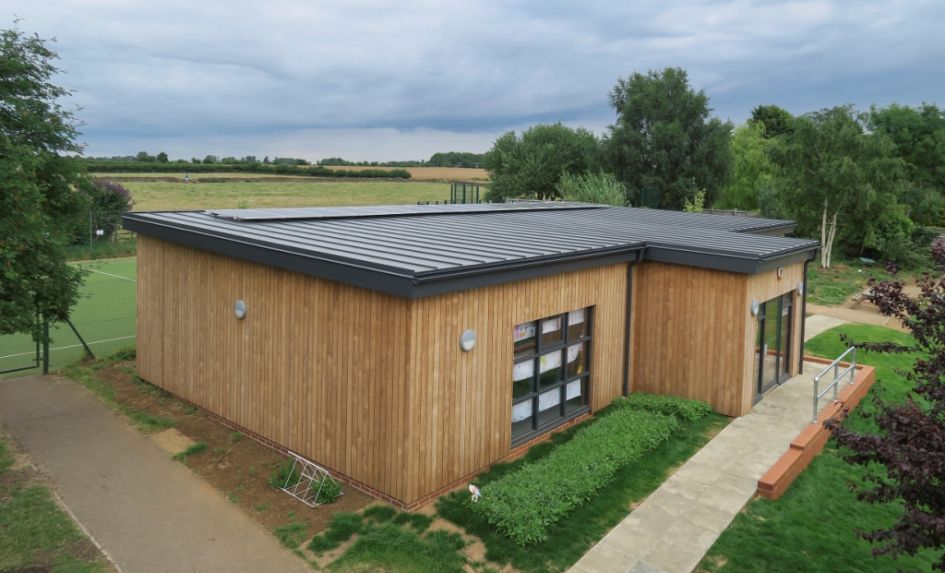With a pupil roll of approximately 100, Croughton All Saints Primary School may be small but has quite the history, having been founded in 1842. Its roots can still be seen to this day, with one of its buildings retaining a thatched roof. A second building was constructed in the 70s to house the school’s main hall, classrooms, staff facilities and office, and until recently, there had also been a mobile building at the rear with a storied history of its own.
Originally given to school by its LA (albeit for a fee) after a severe flooding incident, the mobile building soon became a permanent addition, initially serving as a teaching space for older pupils before being repurposed as a nursery space and leased out to a local provider to generate additional income.
In recent years, however, it was plain to see that the mobile building was barely fit for purpose. “It had a flat roof that kept having to be repaired,” remembers Headteacher Helen Goulder. “The pipes froze in the winter and would flood, so it really wasn’t ideal. It got to the point where we were spending more on maintaining it than we were getting in terms of income.” It was eventually decided, towards the end of 2013, that the mobile building and the space it had occupied for almost a decade would instead be used as the site for a new permanent building as part of plans for the school to expand.
“I’d been at the school for many years, but had just taken over as Head and was very passionate about promoting our school and making sure we were sustainable,” Mrs Goulder explains. “When you have 74 pupils and other schools in the area, you have to do something over and above to encourage parents to send their children here.”
Using funds generated by the nursery income and the extra funding that came with a gradually growing pupil population, Mrs Goulder and her colleagues set about looking into what options might be available and what the costs would involve. An early quote reached almost £300,000, far beyond the school’s available budget, prompting the plans to be temporarily put on hold.
Three years later, with the pupil population now at 111 and the need for additional classroom space more pressing than ever, the school turned to Broadwater Management – a management consultancy that had previously helped the school with installing solar panels on its 1970s building.
With their assistance, Scotts of Thrapston – a Northamptonshire-based joinery manufacturer specialising in the construction of timber buildings – was persuaded to assemble a solar panelequipped off-site manufactured building that could serve as a proof of concept for what the company was able to do. With a brief drawn up, a bid submitted through the council that fell within the school’s £110,000 budget and due process attended to, the ground works began in February 2017.
Heavy lifting
As Bryn Lee, Design Manager at Scotts of Thrapston recalls, the project largely proceeded without problems, bar the need to demolish and remove the old mobile building, and the somewhat limited access for the two days of heavy lifting. “We had to work around the fact that we could only position the lifting equipment at the front of the site. The spot for the new building was about 18 metres away, so we needed equipment that was both light enough not to sink, but also able to extend out far enough.”
Assembled from pre-fabricated components manufactured off-site, the building’s design comprised a beam and block floor structure built atop a concrete foundation, upon which the team installed a series of timber frame wall panels, followed by a series of glulam (glued laminated timber) columns. Above these were added a set of glulam beams and a metal web joist roof structure. Factoring in the installation of the building’s aluminium doors, windows, wiring and lining, the total build time amounted to approximately 13 weeks.
“It all went really smoothly,” remembers Mrs Goulder. “The staff had to temporarily park somewhere else, but that was manageable. We had no complaints over how the site was secured. There were no health and safety issues, considering our main playground was on the other side of the building site. At no point did we feel that the children’s safety was compromised by the machinery on-site.”
Ideal views
The completed building houses two classrooms for school’s KS2 pupils, along with three toilet facilities (boys’, girls’ and disabled) and a dedicated space for lockers. “The children love it out there,” comments Mrs Goulder. “I’d initially been slightly concerned that the classrooms wouldn’t be large enough, but space they provide is amazing. There are floor-to ceiling windows that look out over farmland behind the school, so the views couldn’t be better.”
Croughton All Saints Primary School croughtonallsaints.org.uk
Scotts of Thrapston scottsofthrapston.co.uk










